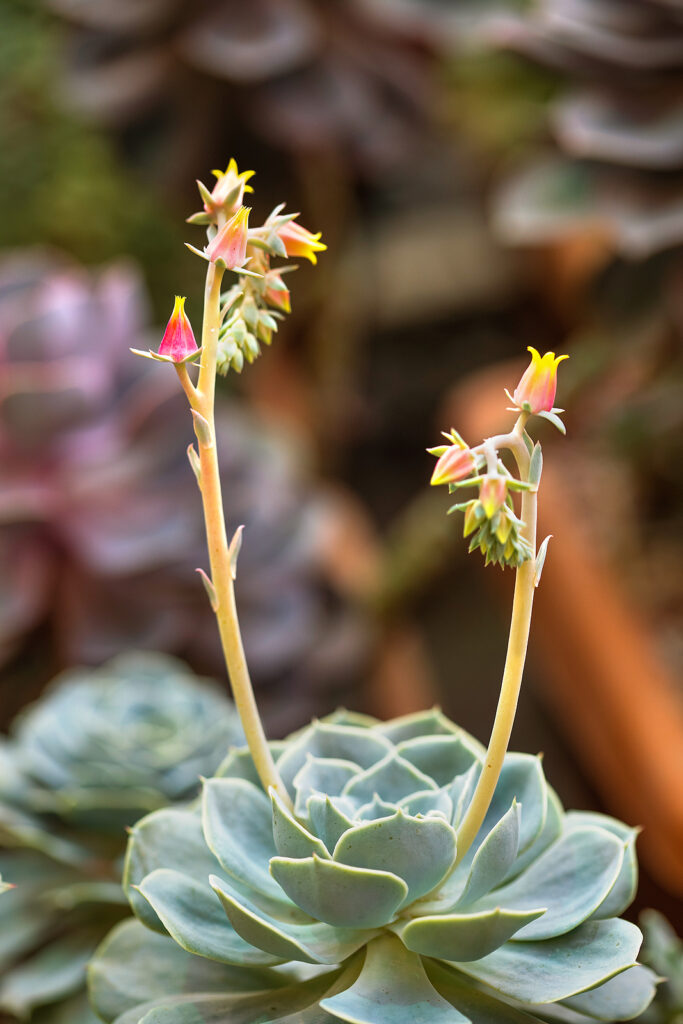Echeveria is a genus of succulents with handsome, fleshy-leaved almost stemless rosettes that are near geometrically perfect. They spread like flower petals, Echeveria are prized for their shape, color, and leaf texture.
Echeveria rosettes vary from just more than an inch wide to 8 inches (20cm) wide. The leaves vary from thin to thick, smooth to pubescent, and come in many colors including soft pastel shades of blue, pink, purple, and red.
There are numerous Echeveria hybrids. Many hybrids have been bred for large, colorful leaves that range from wavy or carbuncled.
Echeveria are easily grown indoors as long as the light is strong and bright. Echeveria grows best if it is set outside in the sun during the summer.
Echeveria is a genus of about 100 species. Echeveria is native to semi-desert regions in Texas, Mexico, and Central America
Get to know Echeveria
- Plant type: Succulent in the Crassula family
- Growing range and zones: Zones 101-12
- Hardiness temperature: Hardy to 30℉ (-1.1℃)
- Optimal growing temperature: day, 70° to 85°F (21° to 29°C); night, 65° to 70°F (18° to 21°
- Foliage: Leaves usually arranged in spiral rosettes; leaves can be green, white-ringed, redish blue-green, dark-purple-red
- Flowers: Erect or spreading petal lobes yellow to red flowers; flowers are borne on racemes on long stalks
- Bloom time: Summer
- Uses: Rock garden
- Common name: Echeveria, painted lady, plushplant
- Genus name: Echeveria
- Family name: Crassulaceae
- Origin: Texas to Central America

Planting Echeveria
- Grow Echeveria in a sunny, airy spot, outside in the summer.
- Grow Echeveria indoors in full sun from southern exposure. Does well under artificial light, needing 16 light-hours daily.
- Grow Echeveria in sandy, humous soil that is low in nitrogen.
How to water and feed Echeveria
- Watrer Echeveria lightly and regularly; do not let water get on the rosettes or they will rot.
- Feed Echeveria every 6 weeks during growing season, with low-nitrogen, high-potassium fertilizer.
Echeveria care
- Repot Echeveria when plant crowds pot or roots occupy 2/3 of pot space.
- Give Echeveria a winter rest period in a bright light, not too warm sport, below 50℉ (10℃). Decrease water; withhold fertilizer.
Growing Echeveria as a houseplant
- Echeveria derenbergii and E. setosa are often grown as houseplants.
- Grow Echeveria at average room temperature and humidity in direct light.
- Use an average to sandy potting medium and allow it to dry out between waterings.
- In winter, water only to keep the plant from shriveling.
- Fertilize Echeveria monthly in spring and summer.
Echeveria pests and diseases
- Check Echeveria for aphids, mealybugs, spider mites, scale. Also, be alert for fungus disease.
Echeveria propagation
- Propagate Echeveria by offsets, stem or leaf cuttings, or by head cuttings.

Echeveria species to grow
- Echeveria E. affinis has waxy, dark green leaves; red flowers appear in winter.
- E. agavoides (molded wax). Light green rosette with red-tinged pointed leaves; red and yellow flowers in spring.
- E. derenbegii (painted lady). Pale green rosette resembles a miniature artichoke; smooth pale green leaves with red edges; reddish yellow flowers in winter and spring.
- E. elegans (pearl echeveria). Densely leafed rosette is somewhat translucent; spoon-shaped, bluish leaves with pink tips; reddish yellow blooms; produces offset.
- E. gibbiflora. Large, blue-green leaves with a bronze sheen, edged in red; scarlet flowers with yellow insides appear in late winter.
- E. peacockii. Silver-blue leaves with red edges; red flowers appear in clusters.
- E. pulvinata (chenille plant). Flattened silver-green leaves covered with fine, white hairs; red and yellow flowers in winter.
- E. ‘Pulv-Oliver’. 2 inch (5 cm) long leaves arranged in a rosette with a dense covering of hair; flowers are deep red.
- E. setosa (Mexican firecracker). Dark green, 4-inch-wide stemless rosette has white hairs, red blooms with yellow tips.



